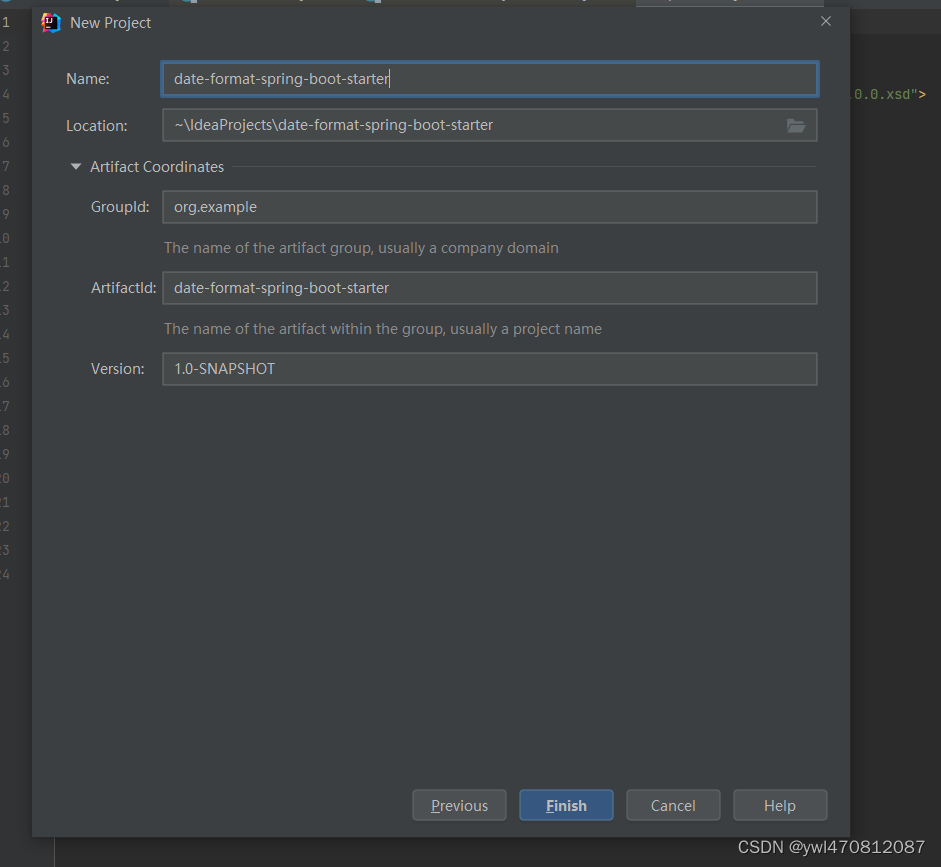从前从前,有个面试官问我一个 SpringBoot Starter 的开发流程,我说我没有写过 starter,然后就没有然后了,面试官说我技术深度不够。
我想说这东西不是很简单吗,如果要自己写一个出来也是分分钟的事情。至于就因为我没有写过 starter 就觉得我一点都不会 SpringBoot 吗?
当然我当时确实水平不足,连 Java 的 SPI 都忘了是啥,后来又捡了起来,原来我在大学的时候就用过 Java 的 SPI,悔之晚矣!
starter 是 SpringBoot 的一个重要的组成部分,它相当于一个集成的模块,比如你想用 Mybatis 和 lombok,但是在 pom 文件中需要写两个依赖,如果你将他们集成为一个 starter(或者将更多你需要的依赖集成进去),那么你只需要在 pom 文件中写一个 starter 依赖就可以了,这对于一个可复用模块的开发和维护都极为有利。
同时,在 maven 中引入 starter 依赖之后,SpringBoot 就能自动扫描到要加载的信息并启动相应的默认配置,它遵循“约定大于配置”的理念。
1、环境说明
jdk 1.8.0_151
maven 3.6.3
IDEA 编译器
要开发的 starter 是一个日期格式化工具,它的功能是可以指定如何格式转化日期类型,同时在配置文件中可以开启关闭此功能
2、创建项目
在 IDEA 中新建一个 maven 工程,如下图所示。

Spring 官方建议自定义的 starter 使用 xxx-spring-boot-starter 命名规则,以区分 SpringBoot 生态提供的 starter。
然后需要在 pom 文件中加入实现 starter 所需要的依赖。
<?xml version="1.0" encoding="UTF-8"?>
<project xmlns="http://maven.apache.org/POM/4.0.0"xmlns:xsi="http://www.w3.org/2001/XMLSchema-instance"xsi:schemaLocation="http://maven.apache.org/POM/4.0.0 http://maven.apache.org/xsd/maven-4.0.0.xsd"><modelVersion>4.0.0</modelVersion><groupId>org.walker.planes</groupId><artifactId>date-format-spring-boot-starter</artifactId><version>1.0-SNAPSHOT</version>
<dependencies><dependency><groupId>org.springframework.boot</groupId><artifactId>spring-boot-autoconfigure</artifactId><version>2.3.0.RELEASE</version></dependency></dependencies>
</project>3、创建配置信息实体类
在开发 SpringBoot 项目的时候,我们有时候会在 application.properties 配置文件中进行一些配置的修改,用以开启或修改相关的配置,如 server.port 可以用来修改项目启动的端口,所以在编写自定义日期格式化 starter 时,也可以用到这个功能,根据配置文件来开启或关闭某项功能。
我们在 application.properties 配置文件中新增两个配置项,第一个是用来控制该 starter 的启动或关闭,第二个是需要指定的格式化信息。
然后创建一个配置文件映射类,它的私有成员变量 pattern 就是需要在配置文件中指定的属性,如果没有指定默认值为 yyyy-MM-dd HH:mm:ss。
import org.springframework.boot.context.properties.ConfigurationProperties;
/*** 配置信息实体类* @author Planeswalker23* @date 2022-12-25*/
@ConfigurationProperties("formatter")
public class DateFormatProperties {
/*** default format pattern*/
private String pattern = "yyyy-MM-dd HH:mm:ss";
// 忽略 getter setter
}@ConfigurationProperties(prefix = “formatter”) 注解的作用是将相同前缀的配置信息通过配置项名称映射成实体类。在这里就可以将 application.properties 配置文件中前缀是 formatter 的配置项映射到 DateFormatProperties 类中。
4、创建配置类
然后我们需要创建一个配置类,这个配置类能够将核心功能类注入到 Ioc 容器,使得在其他引用此 starter 的项目中能够使用自动配置的功能。
import org.springframework.boot.autoconfigure.condition.ConditionalOnProperty;
import org.springframework.boot.context.properties.EnableConfigurationProperties;
import org.springframework.context.annotation.Bean;
import org.springframework.context.annotation.Configuration;
import java.text.SimpleDateFormat;
/*** 配置信息实体类* @author Planeswalker23* @date 2022-12-25*/
@Configuration
@EnableConfigurationProperties(DateFormatProperties.class)
@ConditionalOnProperty(prefix = "formatter", name = "enabled", havingValue = "true")
public class DateFormatConfiguration {private DateFormatProperties dateFormatProperties;public DateFormatConfiguration(DateFormatProperties dateFormatProperties){this.dateFormatProperties = dateFormatProperties;}
@Bean(name = "myDateFormatter")public SimpleDateFormat myDateFormatter() {System.out.println("start to initialize SimpleDateFormat with pattern: " + dateFormatProperties.getPattern());return new SimpleDateFormat(dateFormatProperties.getPattern());}
}这里 starter 的功能是基于 SimpleDateFormat 类的,其实就是解析配置文件中的指定格式,将其设置为 SimpleDateFormat 的 pattern 属性,然后将 SimpleDateFormat 类作为“组件”注册在 Ioc 容器中,这样我们就可以在引用了该 starter 的项目中使用自定义格式化功能了。
@Configuration 注解的作用是将 DateFormatConfiguration 类作为配置类注入容器
@EnableConfigurationProperties 注解的作用是开启资源实体类的加载,也就是说开启配置文件映射为资源实体类的功能。
@ConditionalOnProperty 注解是开启条件化配置,也就是说只有在配置文件中的 formatter.enabled 属性的值为 true 时,这个 starter 才会生效。
5、指定自动装配
至此开发的业务代码就结束了,但是还有一个最重要的步骤就是指定 DateFormatConfiguration 类作为自动装配类。
这需要在 resource 目录下创建 MATE-INF 文件夹,并创建一个名为 spring.factories 的文件,然后在文件中写下
org.springframework.boot.autoconfigure.EnableAutoConfiguration=org.walker.planes.DateFormatConfiguration
这行代码的意思就是将 DateFormatConfiguration 设置为自动装配类,在 SpringBoot 工程启动时会去扫描 MATE-INF 文件夹的 spring.factories 文件,并加载这个文件中指定的类,启动自动装配功能。
6、发布&测试
然后在命令行中敲下 mvn clean install 命令,当看到下面的输出后,自定义的 starter 就可以作为一个依赖被引用了。
[INFO] -----------------------------------------------------------
[INFO] BUILD SUCCESS
[INFO] -----------------------------------------------------------
[INFO] Total time: 1.470 s
[INFO] Finished at: 2020-05-25T20:24:49+08:00
[INFO] -----------------------------------------------------------
新建一个测试工程,在 pom 文件中加入如下的依赖。
<dependency><groupId>org.walker.planes</groupId><artifactId>date-format-spring-boot-starter</artifactId><version>1.0-SNAPSHOT</version>
</dependency>
然后在 application.properties 文件中开启自定义 starter 的配置。
formatter.enabled=true
formatter.pattern=yyyy-MM-dd
然后在启动类中创建一个 Runner 任务,简单的输出一个日期类,就像下面这样。
@SpringBootApplication
public class FirstStarterApplication implements ApplicationRunner {public static void main(String[] args) {SpringApplication.run(FirstStarterApplication.class, args);}@Overridepublic void run(ApplicationArguments args) throws Exception{System.out.println(simpleDateFormat.format(new Date()));}@Resource(type = SimpleDateFormat.class)private SimpleDateFormat simpleDateFormat;
}
启动项目,我们可以看到自动配置生效了,程序将配置文件中指定的格式化样式覆盖了默认的 pattern。
至此,我们已经完成了一个简单的 SpringBoot Start 的开发了,最后来总结一下一个 starter 的开发流程。
- 引入 spring-boot-autoconfigure 依赖
- 创建配置实体类
- 创建自动配置类,设置实例化条件(@Conditionalxxx注解,可不设置),并注入容器
- 在 MATE-INF 文件夹下创建 spring.factories 文件夹,激活自动配置。
- 在 maven 仓库发布 starter

!)

















)